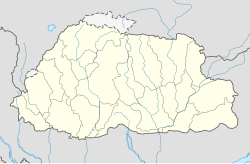Simtokha Dzong
| Simtokha Dzong | |
|---|---|

Simtokha Dzong
|
|
|
|
|
| Coordinates | 27°26′17″N 89°40′10″E / 27.43806°N 89.66944°E |
| Monastery information | |
| Location | Thimphu, Bhutan |
| Founded by | Ngawang Namgyal |
| Founded | 1629 |
| Type | Tibetan Buddhist |
| Architecture | Dzong architecture |
Simtokha Dzong ('dzong' means "castle-monastery") also known as Sangak Zabdhon Phodrang (Bhutanese language meaning: "Palace of the Profound Meaning of Secret Mantras") is a small dzong. It was built in 1629 by Zhabdrung Ngawang Namgyal, who unified Bhutan. It is the first of its kind built in Bhutan. An important historical monument and former Buddhist monastery, today it houses one of the premier Dzongkha language learning institutes. It recently underwent renovation.
The dzong is at strategic security location on a prominent ridge vis-a-vis the Thimpu valley and approach roads to the Dochu La and eastern Bhutan. The Simtokha is located about 5 kilometres (3.1 mi) south of the Bhutanese capital of Thimphu.
The Simtoka Dzong, built in 1629 by Zhabdrung Ngawang Namgyal, functions as a monastic and administrative centre and is the oldest dzong which has survived in its original form; Namgyal brought into vogue, for the first time in Bhutan, this concept of the "dzong" as castle monastery. An attack on the dzong was made by five disgruntled lamas in collaboration with an invading army of Tibetans who were against the Buddhist practices of the dzong under the control of Zhabdrung. They were defeated and Palden Lama who was the leader of the invaders died in the battle. Another attack on the dzong in 1630 by the Tibetans was successful for a while till part of the dzong caught fire and with the roof collapsing all the invading forces were killed.
The first renovation and extension works on the dzong was completed in 1670 by Mingyur Tenpa, the third Druk Desi (regent). It has undergone many renovations in subsequent years also and the most recent refurbishing was carried out by architects from Japan.
It is believed that the dzong provided protection against a demon which had disappeared into a rock close to the site and hence taken the name 'Simtoka' meaning "simmo" (demoness) and 'do' meaning "stone".
The Buddhist school of Linguistics was established as part of the dzong by King Jigme Dorje Wangchuk at the suggestion of Queen Mayum Choying Wangmo Dorje, in 1961.
The dzong, covering an area of about 60 m2 (650 sq ft), has only one entry gate from the south while in the past it was on the west. The dzong built over three floors is covered on the exterior at the lowest level with prayer wheels where there is also an array of 300 carvings made of slate which depict saints and philosophers. The main lhakhang (chapel) has a large image of the Sakyamuni (Buddha), with images of eight bodhisattvas on both sides. There are many dark mural paintings within this lakhang which are said to be the oldest in Bhutan. The chapel to the west of the main Lhakahan has images of Chenresig, green and white Taras (designated as both green and white). There is also an old painting of Zhabdrung Ngawang Namgyal, the founder of the dzong which was cleaned in 1995 but still shows signs of cracks. Also seen on the pillars of the eastern goenkhang are the tiger's tails and guns. There are chapels dedicated to the Yeshe Goennpo (Mahakala) and Pelden Lhamo, the protector deities of Bhutan.
...
Wikipedia

